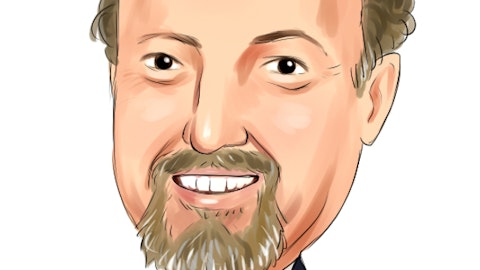Stanley Black & Decker, Inc. (NYSE:SWK) Q3 2023 Earnings Call Transcript October 27, 2023
Operator: Welcome to the Third Quarter 2023 Stanley Black & Decker Earnings Conference Call. My name is Shannon, and I will be your operator for today’s call. At this time, all participants are in a listen-only mode. Later we will conduct a question-and-answer session. Please note that this conference is being recorded. I will now turn the call over to the Vice President of Investor Relations, Dennis Lange. Mr. Lange, you may begin.
Dennis Lange: Thank you, Shannon. Good morning, everyone. And thanks for joining us for Stanley Black & Decker’s 2023 third quarter webcast. On the webcast in addition to myself is Don Allan, President and CEO; Chris Nelson, COO, EVP, and President of Tools and Outdoor; and Pat Hallinan, EVP and CFO. Our earnings release which was issued earlier this morning and a supplemental presentation, which we will refer to are available on the IR section of our website. A replay of this morning’s webcast will also be available beginning at 11 a.m. today. This morning, Don, Chris, and Pat will review our 2023 third quarter results and various other matters followed by a Q&A session. Consistent with prior webcast, we are going to be sticking with just one question per caller.

A workshop full of tools and supplies, showcasing the range of products available.
And as we normally do, we will be making some forward-looking statements during the call based on our current views. Such statements are based on assumptions of future events that may not prove to be accurate, and as such, they involve risk and uncertainty. It’s therefore possible that the actual results may materially differ from any forward-looking statements that we may make today. We direct you to the cautionary statements in the 8-K that we filed with our press release and in our most recent 34 Act filing. I will now turn the call over to our President and CEO, Don Allan.
Don Allan: Thank you, Dennis, and good morning, everyone. Stanley Black & Decker’s third quarter performance reflects the continued successful advancement of our strategic business transformation. Our focused execution resulted in improvements versus prior year in adjusted gross margin and earnings per share, as well as free cash flow. Reflecting on our journey over the last five quarters, we have made significant progress. One, our cost and inventory position is healthier behind the momentum of our supply chain transformation and we are confident in the runway for this to continue. Two, our execution is stronger and the results now demonstrate the focus across the organization to enhance the customer experience and improve our financial position.
Three, our performance today provides a solid foundation for the additional investments we are launching in innovation and market activation to capture the compelling long-term growth opportunities in the markets we serve. Four, our view is that the markets will remain dynamic. Our focus is on delivering best-in-class product innovation through our portfolio of world class brands, implementing cost efficiency measures within our control and driving share gain in our core markets. All aim to further improve margin, earnings and cash flow. While there are many important steps ahead of us on our journey, I am confident that we have the right strategy, a highly capable and motivated leadership team, and a strong competitive position to successfully execute our transformation.
Shifting now to our third quarter performance. Revenue was $4 billion, which was down versus the prior year primarily due to lower Outdoor and DIY volume. The demand for our Pro Tools, as well as automotive and aerospace fasteners remained healthy and demonstrated growth in the quarter. Across our end markets, the U.S. retail point-of-sale for our Tools and Outdoor products remained in a growth position this quarter versus 2019 levels. As we assess our competitive positions and demand trends, we believe that we are stabilizing our share position in a mixed market environment, while we continue to invest in market activation and field resources to drive future share gains. Our Global Cost Reduction Program delivered $215 million of pretax run rate savings in the quarter, on track for the expected $2 billion run rate savings by the end of 2025.
Adjusted gross margin rose to 27.6%, a 400-basis-point sequential improvement and 290 basis points favorable as compared to last year. The benefits from our inventory optimization and supply chain transformation are now clearly being reflected in our performance. As we navigate uncertain market conditions, we are continuing to focus on what is within our control to improve our margins. Looking ahead to 2024, we expect additional sequential and year-over-year gross margin gains. We delivered approximately $300 million of inventory reduction this quarter, which brings us to $1.7 billion reduction since mid-2022 when we started this journey. This contributed to over $360 million of Q3 free cash flow generation, which supported our quarterly dividend and $285 million of debt reduction in the quarter.
Benefits from lower supply chain costs contributed to third quarter adjusted diluted EPS of $1.05, which was better than our plan. Our year-to-date performance supports increasing our 2023 full year adjusted diluted EPS guidance to a range of $1.10 up to $1.40, which would be up $0.25 at the midpoint. I want to thank our 50,000 plus employees around the world for their focus, dedication and passion that contributed to another successful step forward in the third quarter. Our progress is encouraging and I am confident that by executing our strategy, we are positioning the company to deliver higher levels of organic growth, profitability and cash flow, as well as strong long-term shareholder returns. Now shifting to our third quarter segment results.
I will discuss our Industrial business performance and then pass it to Chris Nelson to review the Tools and Outdoor results. Third quarter Industrial revenue declined 4% versus last year, as price realization and currency were more than offset by lower volume and a 3-point impact from our Q3 2022 Oil and Gas business divestiture. We improved Industrial adjusted operating margin by 110 basis points versus prior year, driven by continued price realization and cost actions to deliver adjusted operating margin of 12.2% in the quarter. This represents strong execution and continued year-over-year margin expansion for our Industrial team. Within this segment Engineered Fastening organic revenues were up 6%, including aerospace growth of 29% and auto growth of 9%, as we continue to capture the strong cyclical recoveries in these markets, which was partially offset by what occurred in industrial fastening.
Our Attachment Tool business experienced organic revenue declines, primarily as a result of customer destocking to normalize their inventory levels. The long-term fundamentals for growth remain solid in all these businesses and we believe the temporary channel inventory destocking in Attachment Tool will be complete as we exit 2023. I want to thank the Industrial business for their strong execution. This is the fifth consecutive quarter of double-digit adjusted operating margin for the segment. We are excited by the runway for growth, share gain and operating leverage in these businesses. I will now turn the call over to Chris to review our Tools and Outdoor performance.
Chris Nelson: Thank you, Don. And good morning everyone. I am now at the 4.5-month mark at Stanley Black & Decker and this period has really reinforced my excitement about the future for this business. I have spent my time with end-users, customers and our passionate and highly capable Tools and Outdoor organization. We have iconic brands such as DEWALT, CRAFTSMAN, Stanley and Cub Cadet, a strong pipeline of innovation, and customers and users who are eager for our newest products. We remain focused on capturing that opportunity. We are rapidly making progress with our transformation. The organization remains committed to supporting the necessary cost efficiencies as we prioritize the additional investments in innovation, brand support and commercial resources that will be most impactful to reaccelerate growth and share gain in the market.
Now turning to the Tools and Outdoor third quarter performance. Total revenue was $3.4 billion, down 5% organically versus prior year as a result of lower consumer Outdoor and DIY market demand. Our Tools SPUs in aggregate were positive organically in the quarter, excluding the Russian business exit, while Outdoor, was down 23% consistent with our expectations. Price for the segment was down 2 points in the period, as we successfully regained margin accretive cordless promotions consistent with historical activity. We made substantial progress in improving adjusted operating margin to 9.3%, this was a sequential step up of 480 basis points and 250 basis points better than last year. This improvement was driven by reduced sell-through of high cost inventory, supply chain transformation savings and reduced shipping costs, which were partially offset by lower organic revenue.
In terms of performance by region, North America was down mid-single digits organically similar to the overall segment North America Tools organic growth was positive, while Outdoor declined. U.S. retail point-of-sale for the quarter remained above pre-pandemic 2019 levels supported by strength in professional demand and price. Third quarter POS for DEWALT was positive versus last year, supported by promotions, our pro-inspired new product offerings and sustain professional demand. Our European organic revenue was down 3% with bright spots from double-digit organic growth in the U.K. and low single-digit growth in the Nordics. We are leveraging targeted programs to capture professional share with DEWALT cordless tools. In emerging markets, we grew mid-single digits organically, excluding the impact from the Russia business exit.
Including this impact, organic sales declined 4%. Solid emerging markets performance was led by Latin America, which is now recorded four consecutive quarters of organic growth. We have seen notable strength in Brazil, particularly within the professional channels. Moving to our strategic business unit performance. The hand tools business grew 2% organically versus prior year. This includes mid-single-digit organic growth in North America and Latin America, supported by expanded offerings at our retailers and strong new product sales. Power Tools declined 2% organically, pressured by Consumer Tools. Pro driven momentum coupled with positive impacts from a healthier supply chain is supporting enhanced service levels and promotional opportunities.
Transitioning to Outdoor, organic revenue declined due to market demand choppiness as the industry resets from the pandemic era. This resulted in fewer shipments in the quarter as there are elevated inventory levels globally impacting replenishment cycles. Despite the current market environment, we are excited about the long-term opportunity and bringing leading innovation to Outdoor across our powerful brands. I want to thank the team for their strong execution in the quarter as we continue to focus on winning with our customers and capturing this amazing growth margin and shareholder return opportunity. Turning to the next slide, I would like now to highlight a few examples of how we are evolving our trade focused offerings and Cordless Outdoor expansion.
With Professional Trades torque cordless impact wrench in its class, ideal for use in heavy-duty applications. We also introduced the world’s first battery charger box, The DEWALT TOUGHSYSTEM 2.0 Dual-Port Charger. Users now can protect store and charge dual batteries in a durable weather resistant container to keep professional’s productive despite rough job site conditions. In Outdoor as we gear up for winter, DEWALT has entered the snow category with the 60-volt MAX Single Stage Snow Blower. Powered by two flexible batteries, it is engineered to tackle tough demands and breakdown heavy wet or pack snow. Our Pro inspired innovation roadmap will continued to introduce solutions across our categories that enhanced safety on the job site while elevating power and performance.
Now changing gears into DEWALT’s new involvement with our social responsibility efforts, we are working to close the trade skills gap and shaping the future of construction technology and the electrical and plumbing trades. In the third quarter, we opened the 2023 DEWALT Grow the Trades Grant and Trades Scholarship program. These initiatives provide non-profits with the necessary resources to train, reskill and prepare tomorrow’s trades people by directly supporting end-user trade education. This is a great example of our broader commitment to invest $30 million to grow trade skills by 2027. Now I will turn the call back to Don.
Don Allan: Thanks, Chris. I appreciate the energy and perspective that you have brought to the team and I am excited to continue our company’s strategic business transformation with you as a key leader on our strong management team. Turning to the next slide, I would like to reinforce the focus areas across our company’s transformation. One, streamlining and simplifying the organization, as well as shifting resources to prioritize investments that we believe have a positive and more direct impact for our end-users and various channel customers. Two, accelerating the operations and supply chain transformation to return adjusted gross margin to historical 35% plus levels, while improving fill rate to better match inventory with customer demand.
Three, prioritizing cash flow generation and inventory optimization. And then four, continuing to advance innovation, electrification and global market penetration to achieve organic revenue growth of 2 times to 3 times the market. We believe this strategy will ensure our best in class product innovation is maintained, while we continue to meet or exceed the expectations of our end-users and we dramatically improved the channel customer experience. In parallel, we will maximize cost opportunities within our control to fuel investment as we deliver our margin, earnings and cash flow goals. As our margins expand, our focus is to accelerate share gains. We are prioritizing innovation and market activation investments across our powerful brands and targeting the best prospects to maximize share gain growth and return.
We continue to benefit from being a simpler, more focused company across Tools and Outdoor and Industrial, and we expect over the next 12 months to 18 months, we will find opportunities for further simplification across our businesses. As we evaluate where to invest and the best ways to maximize shareholder return, we will continue to take a pragmatic view of our portfolio of businesses. Our track record demonstrates we will act decisively when the time is right on those portfolio decisions. I will now turn the call over to Pat to share the latest progress updates on our transformation, financial insights on the quarter and our revised outlook for the year. Pat?
Pat Hallinan: Thank you, Don, and good morning, everyone. We continue to generate strong transformation results and go-forward momentum. Our cost reduction program delivered approximately $215 million of pretax run rate cost savings in the quarter. Bringing our aggregate savings to approximately $875 million since program inception. This positions us well to deliver our slightly exceed our $1 billion run rate savings target this year and to deliver $2 billion run rate savings by 2025. As it relates to the supply chain transformation, strategic sourcing initiatives remain the largest contributor to supply chain savings since program inception. The early actions focused on strategic components and logistics, as well as other areas.
We have now covered approximately two thirds of the targeted procurement spend, establishing a carry on savings trajectory consistent with that contemplated in the 2024 program target. Our supply chain management and engineering teams will continue to drive sourcing improvement through 2025 and beyond. Activating our Operations Excellence program has also contributed significant savings this year. In the plants where this has been activated, we are seeing increased productivity, leveraging lean manufacturing principles. Our footprint related projects are progressing on schedule with initial savings to begin this year. As it relates to complexity reduction, our teams are assisting customers as they transition to replacement products with the goal of exiting 30,000 SKUs by the end of 2023.
We are confident that our transformation can support the sustainable cost efficiency needed to return our adjusted gross margins to 35% or greater. These actions are creating the flexibility to fund additional organic growth investments in our core business. Turning to our inventory reduction in gross margin improvement. We reduced inventory by approximately $300 million bringing our year-to-date progress to approximately $880 million. The third quarter inventory reduction supported the generation of approximately $360 million of free cash flow in the period, resulting in one of the strongest third quarter cash generations in the company’s history. We have reduced inventory by $1.7 billion since the middle of 2022. We achieved this through improved supply chain conditions, strategic inventory management and the planned production curtailments initiated during the back half of 2022.
We expect modest inventory improvement in the fourth quarter, which would bring our full year 2023 inventory reduction to at or near our 2023 objective of $1 billion as we prepare for next year’s Outdoor season and supply chain network changes. Inventory reduction will be a major contributor to our full year free cash flow target of $600 million to $900 million. Looking to 2024 and beyond, we expect the additional multiyear inventory reduction opportunity to be at or above $1 billion. We expect to pursue further inventory reduction at the pace of $400 million to $500 million per year. We will balance our goal of inventory efficiency with ensuring sufficient working capital. Our priority for capital deployment is to fund our longstanding commitment to return value to shareholders through cash dividends and to further strengthen our balance sheet.
Shifting to profitability. We recorded adjusted gross margin of 27.6%, up 290 basis points versus prior year and improving 400 basis points versus the second quarter. This is the third consecutive quarter that we delivered sequential gross margin improvement. Year-over-year expansion was driven by lower inventory destocking costs, supply chain transformation benefits and reduce shipping costs. All of which more than offset the impact of lower organic revenue. Moving forward, we expect continued adjusted gross margin rate expansion driven by the benefits of the supply chain transformation. Our guidance calls for adjusted gross margin to incrementally improve again in the fourth quarter. Now that the high cost inventory has turn through the P&L, we expect to continue to deliver expanding adjusted gross margin into the first half and full year 2024 supported by the success of our supply chain transformation.
Achieving adjusted gross margins approaching 28% in the third quarter was a significant milestone on our journey to restore 35% plus adjusted gross margin. The momentum of our supply chain transformation is translating to sustainable upward progression in our margins and cash flow, and will provide resources to fund investment to accelerate long-term organic revenue growth toward our goal of 2 times to 3 times the market. Now turning to our 2023 guidance. Our expected GAAP earnings per share range has been revised to negative $1.45 to negative $1 from negative $1.25 to negative $0.50, charges primarily from the global supply chain transformation and Outdoor business integration. The current pretax estimate of acquisition related and other charges is now $425 million to $450 million, with approximately half of these expenses being non-cash.
Based on the strength of the third quarter, we are raising our full year adjusted earnings per share guidance range to $1.10 to $1.40 from our previous guidance range of $0.70 to $1.30. We delivered a strong third quarter cash performance and are maintaining our full year free cash flow target of $600 million to $900 million. We expect fourth quarter cash flow to be supported by positive cash earnings, inventory reduction and the typical seasonal receivables reduction in Tools and Outdoor. The organic growth outlook for the year is unchanged with the total company expected to be down mid-single digits. This implies a revenue midpoint of $15.9 billion for the year and includes estimated risks for auto strikes and continued infrastructure customer destocking.
Turning to important remaining elements of guidance. Our expectation is for production to continue to normalize in the fourth quarter. We remain disciplined and flexible in our approach to invest, to drive organic growth and share gains. Our outlook assumes approximately $125 million of annualized innovation and market activation investment with a goal to ultimately deploy $300 million to $500 million over the next three years. We expect fourth quarter adjusted operating profit to approximate $290 million with adjusted gross margin to sequentially improve to the 28% zone both the business. With that, I will now pass the call back over to Don.
Don Allan: Thank you, Pat. We are pleased to report another quarter of progress on our journey of transforming Stanley Black & Decker. Consistent successful execution against our plan gives us the confidence to increase investments, which will accelerate organic growth behind our most powerful brands. As we continue to focus on what we can control to be successful, I am confident that we are creating a stronger and more focused company with our great people, amazing brands and industry leading end-user inspired innovation. We believe the outcome of our transformation will produce sustainable market share gaining machine. With that, we are now ready for Q&A. Dennis?
Dennis Lange: Great. Thanks Don. Shannon, we can now start Q&A, please. Thank you.
See also 11 Best Gun Stocks To Buy in 2023 and 10 Fastest Growing Regions in the World.
Q&A Session
Follow Stanley Black & Decker Inc. (NYSE:SWK)
Follow Stanley Black & Decker Inc. (NYSE:SWK)
Operator: Thank you. [Operator Instructions] Our first question comes from the line of Julian Mitchell of Barclays. Your line is now open.
Julian Mitchell: Hi. Good morning. And great to hear that update from Chris on the momentum in the Tools business. Maybe my question just around slide nine and some of the commentary there on margins. So, I guess, one is just, it looks like the gross margins up sequentially in Q4, but sort of operating margin down somewhat. So maybe just any sort of moving parts within that worth calling out. And then you talk about the gross margin moving higher sequentially into the first half of next year. So maybe you put that in context for us in terms of what does that tell us about the confidence in that sort of $4 to $5 of EPS number that you have mentioned in the past is perhaps some kind of framework for earnings next year? Thank you.
Don Allan: Thanks for the long multiple questions there, Julian. But good questions, because there are — the things that we are very focused on as far as our margin rate improvement we are really pleased with what occurred in Q3 and what we believe will play out in Q4. And I am going to ask Pat to give us more color on your questions around margin and then tying it into the $4 to $5 for next year, we still feel that that is a good range and potential outcome for us. And Pat will give a little more color on as well. So, Pat.
Pat Hallinan: Yeah. Hey, Julian. Our focus is going to remain margins and cash generation until we are back to the operating model that business has traditionally had. I’d say, gross margins you saw, both effects, the effects of the program driving the cost savings we expected to the tune of, one, 100 basis points to 150 basis points of margin improvement in the quarter. Deflation also help in the quarter mostly from shipping coming off the balance sheet of another 100 basis points to 150 basis points. And then broader high cost inventory coming off the balance sheet of around 300 basis points. And that was our expectation. It’s great to see the teams working hard together to deliver the program on cadence, but as we have been telegraphing to investors, we could see the rate at which high cost inventory was coming off the balance sheet and that came well within our expectations and drove the important gross margin expansion.
From here we have a pathway to 35%, obviously, the pathway going forward, it’s not going to be perfectly linear, but it’s certainly going to be more in the range of 50 basis points to 100 basis points a quarter on gross margin. As our operating margin question, that had more to do with just, it was about $200 plus million less revenue in this quarter and that was really the driver of the operating margin difference as we continue to invest in the business. And we are going to go forward both in the fourth quarter and as we head into a dynamic 2024 focused on continued gross margin expansion and cash generation. We are going to be investing for growth and that’s part of what we are doing in the fourth quarter and that’s what we are going to plan to do in 2024 as well.
But we will be mindful of the macro environment and what that means for cash delivery and de-levering along that route. And the $4 to $5, I would say, given the performance of the business in the back half of the year in a dynamic market. I would still say, we see the $4 to $5 as a reasonable range. Certainly, it’s dependent on the macro and deflation versus inflationary environment. I would say that, the $4 to $5 anticipates a stable or improving macro. If you are at the stable side of the macro, you are probably on the lower side of the range and if you are at an improving macro, you kind of go towards the higher side of that range.
Operator: Thank you. Our next question comes from the line of Tim Wojs with Baird. Your line is now open. Tim Baird, your line is now open. Please check your mute button.
Dennis Lange: Tim?
Operator: Our next question comes from the line of Jeff Sprague with Vertical Research Partners. Your line is now open.
Jeff Sprague: Thank you. Good morning, everyone, and hello, Chris. Good to hear your voice again. The — I guess, maybe a little bit of a multi partner also, but just kind of thinking about, as you pivot from just kind of outright cost reduction to reinvesting for growth and the like. Does all most of this reinvestment happened inside of COGS and the gross margin discussion. How much of it ends up kind of in selling sales force, things that you are doing on kind of developing the trades that you mentioned. And maybe just as part of that selling related question, maybe just a little bit more color on what you are seeing on promotion and just kind of the general pricing environment in the market? Thank you.
Don Allan: Yeah. Jeff, I will ask Chris to give a little more color on that. It clearly is going to be heavily weighted to SG&A and selling resources and activities. But let’s give Chris an opportunity to give you more color on that. Chris?
Chris Nelson: Yeah, Jeff. Thanks a lot. Nice hearing from you again. And what I’d say is that per Don’s comments, as we think about how we are going to move forward, and I would say, have focused investments in the business in the areas that we believe will drive the most leverage, making sure that we see which brands we want to invest in and what levers we want to pull there. And obviously, we have seen the strength of the Pro and there was we did, as far as near-term look, DEWALT was a positive story in the quarter, we need to keep on gathering steam with that. What I’d say is that, as far as in the investment buckets and where we are thinking we could have the most leverage. Certainly having the right products for the professional end-user is a large emphasis for us.
We referenced a few of the launches that we have in the near-term, we are going to continue to double down on those types of investments for the Pro end-user, because of the strength of the brand, as well as what we see in the marketplace. Similarly, we want to make sure that we have the right commercial resources in the right markets on the ground with our customers, working with them on ways that we can grow together, because we really think that there is some great opportunities in the area — in that area. So, that’s where really out of the gate, the emphasis is going to lie. As far as your other question on where we see, what we saw in the promotional activities? We are — we did reference that we are going to be back in returning to traditional levels of promotion and we did that in Q3 and it started our quarter out strong and we are happy to be back in that promotional mindset, because it is an important part of the business and we think it is healthy and accretive for the business going forward.
Now, we also are certainly going to supplement that with the new launches and we are going to lean into the new launches going into the back half of the year to continue that growth. But all in all, we are seeing the, in Q3, our sell-through was in line with our expectations. As far as pricing, we see disciplined in the marketplace as far as no deep discounting and we are going to make sure and continue in our healthy and traditional promotional mix. But then, like I said, also be driving growth organically through leaning into the opportunities that we see with the Pro.





